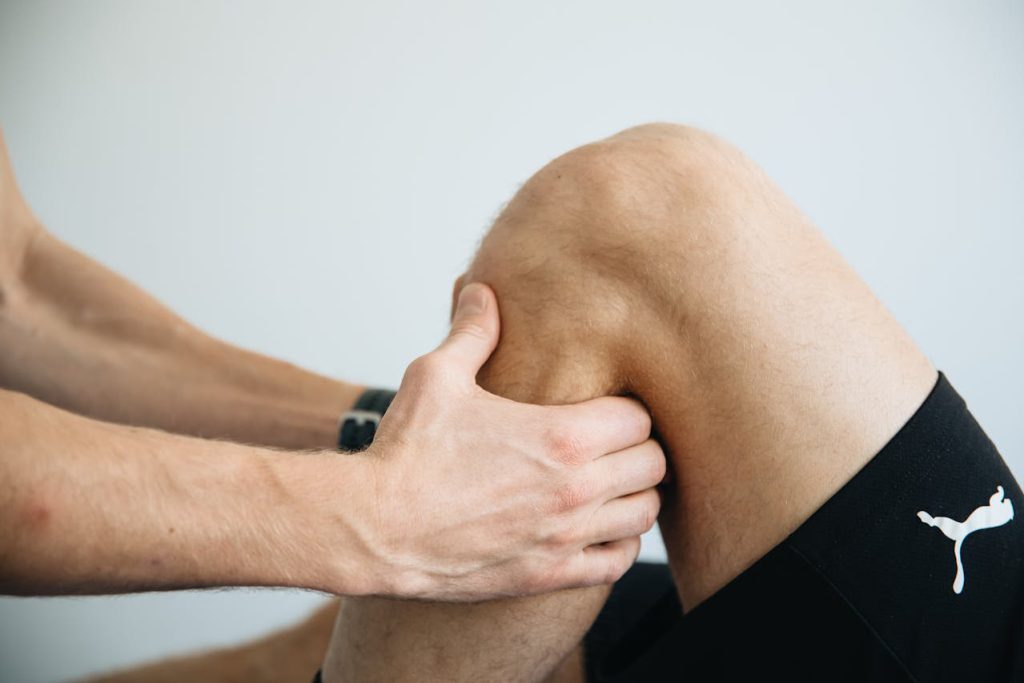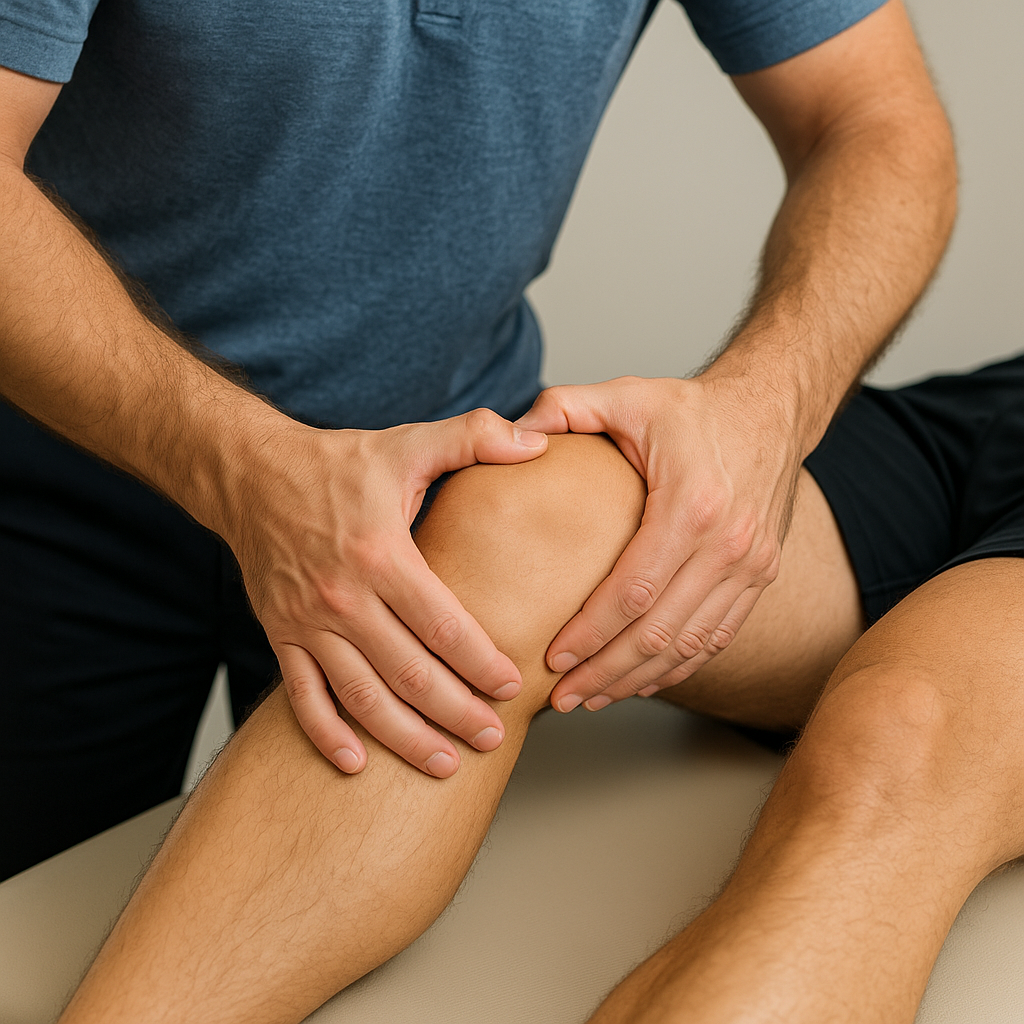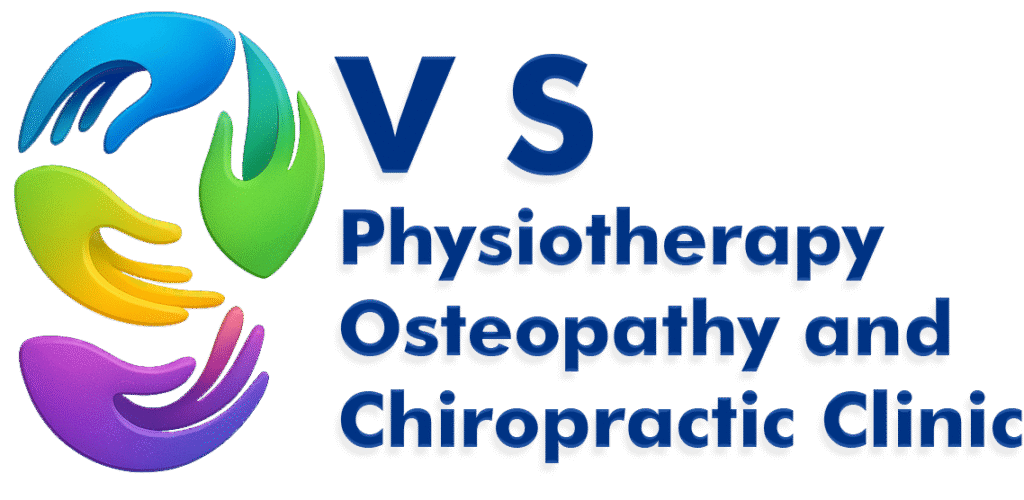Knee pain impacts many of us, making even simple tasks feel difficult. While knee replacement surgery is common for those with serious joint problems, it is not the only option. Physiotherapy can help reduce pain, improve movement, and in many cases, delay or even help us avoid knee replacement surgery altogether.

By working with a physiotherapist, we can strengthen the muscles around our knees, improve balance, and learn safe ways to move. These approaches not only help manage our symptoms but also support our joints as we go about our daily lives. For many, these changes can keep us active without turning to surgery.
Understanding our options gives us more control over our health decisions. As we explore how physiotherapy fits into knee care, we’ll see what steps can make a real difference in avoiding major surgery.
Understanding Knee Conditions and Risk Factors
Knee problems can be caused by many different issues, such as injuries or medical conditions that get worse over time. Knowing the risk factors can help us take steps to protect our knee health and possibly avoid surgery.
Common Causes of Knee Pain
Knee pain often starts with injuries like sprains, ligament tears (such as ACL or MCL injuries), or meniscus damage. Everyday wear and tear can also play a role, especially if we put a lot of pressure on our knees due to sports or heavy physical work.
Arthritis is a big reason for knee pain, especially osteoarthritis, which happens when the cartilage breaks down in the joint. Sometimes, small injuries add up over years and cause long-term pain. Other causes include patellar tendonitis, bursitis, and muscle weakness that affect how the knee moves.
Common sources of pain include:
- Falling or sudden twisting
- Repetitive stress from activities like running
- Weak muscles in the legs
- Extra weight adding pressure to the joint
By understanding these causes, we can focus on prevention and early treatment.
Medical Conditions Leading to Knee Replacement
The main reason people need a knee replacement is because of severe damage to the knee joint, most often from osteoarthritis. This condition wears away the smooth cartilage, causing bones to rub together. That leads to pain, swelling, and stiffness that can get worse with time.
Other medical issues, like rheumatoid arthritis and post-traumatic arthritis, can also harm the knee joint. Infections or old injuries that did not heal well may add to the problem. According to research, knee replacement surgery is more common in people over age 50, with rates rising in those over 70 due to decades of wear and tear.
When pain and loss of movement stop us from doing everyday things, doctors may recommend surgery as a last resort.
Identifying Risk Factors Early
Some risk factors can make knee problems more likely. Age is a big one; our joints naturally wear down as we get older. Carrying extra body weight puts added stress on our knees every day.
Weak muscles and poor physical fitness can also increase the risk. Genetics plays a part, too. If our family members had knee issues, we may be at higher risk. Past injuries, such as broken bones or ligament damage, can set the stage for joint problems to develop later.
We can lower our risk by improving our strength and activity levels, and by maintaining a healthy weight. Learning how to address these risk factors early can help us prevent knee pain and avoid surgery. Early action is key in protecting our knees.
Physiotherapy Techniques to Support Knee Health

Physiotherapy uses proven techniques to address knee pain, support joint mobility, and delay or avoid surgery. We can improve knee strength, function, and pain control with targeted care.
Personalized Exercise Programs
We begin by assessing each person’s condition, activity level, and mobility goals. Based on this, we design custom exercise plans that might include:
- Quad sets
- Straight leg raises
- Step-ups
- Bridging
- Partial squats
These exercises help build muscle around the knee for better support. Stronger quadriceps and hamstrings take pressure off the joint and improve stability. Evidence shows that regular, guided movement can restore normal function, reduce pain, and improve flexibility.
Including low-impact activities like swimming or cycling keeps knees mobile without extra stress. Our goal is to make these routines part of daily life to help protect the knee from further damage. Learn more about useful physiotherapy exercises for knee pain relief.
Manual Therapy and Mobilization
Manual therapy includes hands-on techniques performed by a physiotherapist. We may use joint mobilizations, soft tissue massage, or gentle stretching to target stiff tissues and improve range of motion.
Mobilization reduces joint stiffness, decreases swelling, and encourages proper joint movement. By applying specific, controlled motions, we can address pain points and enhance blood flow. This helps the knee move more freely and function better during daily tasks.
We also focus on correcting joint alignment and reducing muscle tension. With regular treatments, these methods can promote recovery after knee injuries or help with chronic conditions like osteoarthritis.
Pain Management Strategies
Pain can keep people from moving and exercising, but we have tools to help. Physiotherapists use a mix of treatments such as ice or heat therapy, ultrasound, electrical stimulation (like TENS), and supportive taping.
We teach pain-relief techniques that people can use at home, including gentle stretching and pacing of daily activities. Education is also important; understanding how pain works can reduce fears and help us stay active.
Effective pain control lets us continue with exercises and physical activity, which is key for long-term knee health. With a personalized approach, we can manage knee pain and maintain a higher level of function as described in this comprehensive guide to knee pain physiotherapy.
Benefits of Physiotherapy in Preventing Knee Replacement

Physiotherapy offers many proven benefits for those with knee pain and joint problems. Strengthening muscles, controlling swelling, and improving flexibility are important steps that can impact whether we may need knee surgery in the future.
Improved Joint Function and Mobility
One of the main goals of physiotherapy is to help us move better with less pain. When knee movement becomes hard, everyday tasks like climbing stairs or walking can seem impossible. Physiotherapists use targeted exercises that are designed to make our knees stronger and more flexible.
Regular therapy focuses on building up both the quadriceps and hamstring muscles. These muscles support our knees and help keep them stable when we move and put weight on them. Stronger muscles mean less stress on the knee joint.
In addition to exercises, physiotherapists may teach us how to move and walk in ways that reduce pressure from weak or painful areas. They may also recommend balance and coordination exercises. These efforts together mean that many people see real improvements in their ability to walk, bend, or go about their daily routines. Over time, this can lead to a much greater level of independence and confidence.
Reducing Inflammation and Stiffness
Knee pain often comes with swelling and stiffness, making the joint feel tight or locked. Physiotherapy helps us manage these symptoms with gentle stretches, hands-on techniques, and special treatments. Reducing inflammation is important because it can prevent future joint damage.
Common treatments include ice or heat therapy, massage, and ultrasound therapy. These approaches can help us lower swelling, ease pain, and increase blood flow to the area. Simple daily stretching routines can further keep the knees from getting stiff.
Because physiotherapists create custom plans based on our needs, we learn which stretches and treatments suit our condition best. By keeping inflammation under control and joints loose, we have a better chance to maintain knee health and avoid injury over time. Learn more about managing knee pain at Patient.info.
Delaying or Avoiding Surgery
Many people feel worried when they first hear they might need knee surgery. However, several studies and experts agree that physiotherapy can help delay or even avoid surgery for many people with knee arthritis or injuries. Strengthening muscles, protecting cartilage, and building better movement habits all work together to slow down joint damage.
We can often reduce pain and improve function enough that surgery is no longer the only option. People who commit to a regular physiotherapy program may be less likely to need a knee replacement later on. In some cases, the need for surgery drops significantly when people take these steps early. You can read more about delaying or avoiding knee replacement at Pain Free Start and The Doctors of PT.
Working closely with a physiotherapist gives us the tools to protect our knees, manage symptoms, and make informed choices about surgery.
Integrating Physiotherapy Into Your Lifestyle
Making physiotherapy part of our daily routine can protect our knees and improve our movement. Staying committed and working with a team of experts leads to the best long-term results.
Long-Term Knee Care Plans
Long-term knee care plans help us stay active while reducing pain and stiffness. These plans often include regular stretching, targeted exercises, and low-impact activities like swimming or cycling. Building strong muscles around the knee provides better support for the joint, which can help us avoid or delay surgery.
It’s important to set a schedule and stick to it. Even after our pain goes away, we should continue these routines to keep our joints healthy. Using a tracking chart or a journal makes it easier to notice progress and spot changes early.
Following sound advice from a physiotherapist can also teach us easy ways to adjust our posture, protect our joints during daily tasks, and use helpful tools if needed. Making space for physiotherapy in our week makes a real difference for knee health.
Collaborating With Healthcare Providers
Close teamwork with our healthcare providers is key for the best physiotherapy outcomes. Our physiotherapist helps us create a personalized care plan that suits our abilities and lifestyle. They show us the safest ways to exercise and when to rest or adjust activities.
Regular check-ins with our care team allow us to address pain flare-ups, ask questions, and update goals. Doctors might use imaging tools or special tests to guide our treatment choices. When we combine physiotherapy with guidance from doctors, we can maximize knee function and delay or avoid surgery. For more information on this approach, see how to avoid knee replacement surgery with physiotherapy.
By working together, we get support, stay motivated, and can handle challenges before they grow into bigger problems.
Frequently Asked Questions
We often hear key questions from people considering physiotherapy for knee pain and arthritis. It’s important to know what exercises work best, how long improvement can take, and how physiotherapy compares to surgery or other treatments.
What are the most effective physiotherapy exercises to alleviate knee pain?
Strengthening the muscles around the knee, especially the quadriceps and hamstrings, helps take pressure off the joint. Common exercises include straight leg raises, mini squats, and step-ups. Gentle stretching of the calves and hamstrings also helps mobility.
Balance exercises, such as standing on one leg, can improve joint stability. We may also include low-impact aerobic activities like cycling or swimming in a rehab plan.
How long does it typically take for physiotherapy to improve knee function?
Most people see noticeable changes in pain and function after about 6 to 12 weeks of regular physiotherapy. The exact timeline depends on the severity of the arthritis or injury, our age, and how consistently we follow the treatment plan.
Some may feel better sooner, while others need a few months of continued effort to see lasting improvement.
Can physiotherapy treatments delay the need for knee replacement surgery?
Research shows that consistent physiotherapy can help manage knee arthritis, reduce pain, and delay or even avoid knee replacement surgery. By increasing strength and mobility, physiotherapy gives us more time before considering a surgical option.
Regular exercise and targeted treatments may help us avoid or postpone surgery for several years in many cases.
What are the success rates of physiotherapy in treating osteoarthritis of the knee?
Many people with knee osteoarthritis experience less pain and better function after trying physiotherapy. Studies show that up to 70% of patients report an improvement with consistent exercise and professional guidance.
Improvements depend on the stage of arthritis and our dedication to the program.
What is the role of physiotherapy in managing chronic knee conditions?
Physiotherapy helps us control pain, improve joint movement, and build muscle strength. Managing swelling, working on balance, and restoring confidence in activity are also main goals.
It is often used alongside advice about weight management and lifestyle changes to give us long-term relief.
How does physiotherapy compare to other non-surgical treatments for knee pain?
Physiotherapy is a hands-on, personalized approach that often works better than rest or relying only on painkillers. While injections or braces may offer short-term relief, physiotherapy can address the root causes of pain and stiffness.
Physical therapy is commonly recommended as a first-line treatment for knee osteoarthritis due to its focus on movement and strength. See more details on how physiotherapy can help avoid knee replacement.
